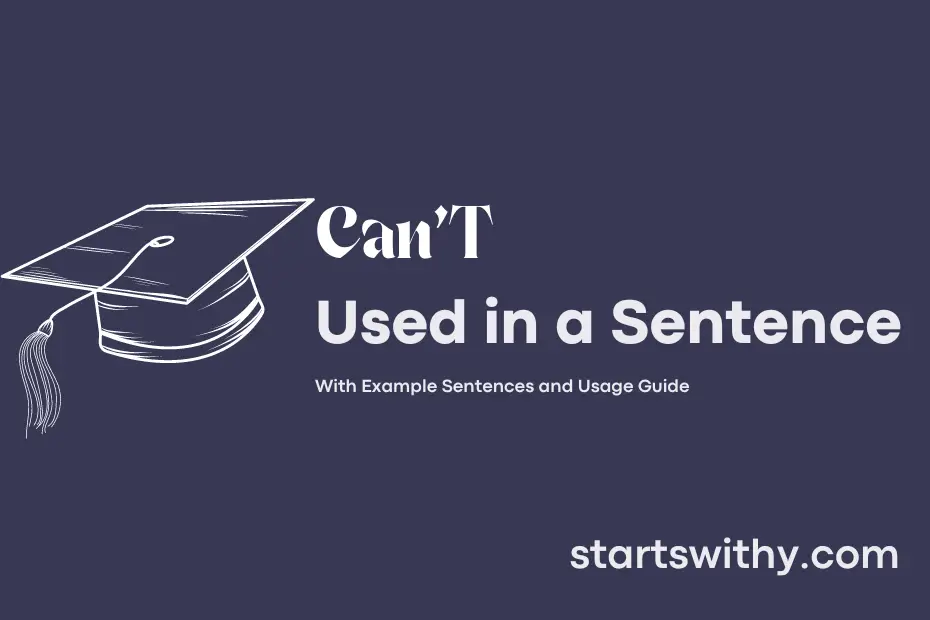Have you ever struggled to express something that is impossible, forbidden, or out of your control? Any statement with the word “can’t” signifies incapability or a restriction. When someone says “I can’t believe it,” they are indicating disbelief or astonishment. This simple contraction, can’t, is a powerful tool in communication.
In grammar, when a sentence contains “can’t,” it often denotes a lack of ability, permission, or possibility. Expressing various degrees of denial, impossibility, or constraint, “can’t” is a versatile term used to convey limitations in speech and writing.
7 Examples Of Can’T Used In a Sentence For Kids
- I can’t fly like a bird in the sky.
- The sun can’t shine during the night.
- I can’t eat ice cream for breakfast.
- The cat can’t bark like a dog.
- I can’t swim without water.
- Plants can’t grow without sunlight.
- I can’t see in the dark without a light.
14 Sentences with Can’T Examples
- I can’t attend the college fest because I have an important exam on that day.
- I can’t afford to buy all the textbooks for this semester.
- I can’t decide which elective course to choose for the next term.
- I can’t believe how expensive the food is at the college canteen.
- I can’t find a quiet place in the library to study for my project.
- I can’t understand this concept no matter how many times I read the textbook.
- I can’t get a good Wi-Fi connection in my dorm room.
- I can’t stay up late tonight; I have an early class tomorrow.
- I can’t borrow my roommate’s laptop because she’s using it for her assignment.
- I can’t participate in the sports tournament due to a knee injury.
- I can’t believe how much my college projects are piling up this semester.
- I can’t figure out how to solve this math problem even after asking the professor for help.
- I can’t submit my assignment on time because my laptop crashed.
- I can’t focus on studying with all the noise coming from the construction work outside.
How To Use Can’T in Sentences?
To Can’t is a contraction of “cannot” and is used to express the inability to do something. Here’s a simple guide on how to use Can’t in a sentence:
-
Negation: Use Can’t to negate a verb, showing that you are unable to do something. For example, “I can’t swim” means you are not able to swim.
-
Contractions: Can’t is often used in casual or informal speech or writing. For example, “I can’t believe it!” instead of “I cannot believe it!”
-
Formality: Avoid using Can’t in formal or academic writing. Instead, use “cannot” for a more professional tone.
-
Position: Can’t is usually placed in the middle of the sentence after the subject and before the main verb. For example, “She can’t attend the meeting.”
-
Questions: To form a question using Can’t, invert the subject and Can’t. For example, “Can’t you come with us?”
-
Emphasis: Use Can’t to emphasize your inability to do something. For example, “I really can’t eat spicy food.”
By following these simple guidelines, you can effectively use Can’t in a sentence to express your inability to do something. Practice using it in everyday conversations to become more comfortable with incorporating it into your vocabulary.
Conclusion
In conclusion, sentences that incorporate the word “can’t” express inability, prohibition, or impossibility. These sentences often highlight limitations or restrictions imposed on a particular situation or action. By using “can’t” in a sentence, the speaker conveys a sense of negation and emphasizes the impossibility of a certain task or outcome. Whether it be expressing personal limitations or setting clear boundaries, sentences with “can’t” play a crucial role in communication by defining what is not achievable or permissible.
Overall, the use of “can’t” adds a definitive and straightforward tone to sentences, making it clear that certain actions or circumstances are not possible or allowed. By recognizing and incorporating these linguistic structures, individuals can effectively convey constraints, boundaries, and restrictions in various contexts, contributing to clear and concise communication.



